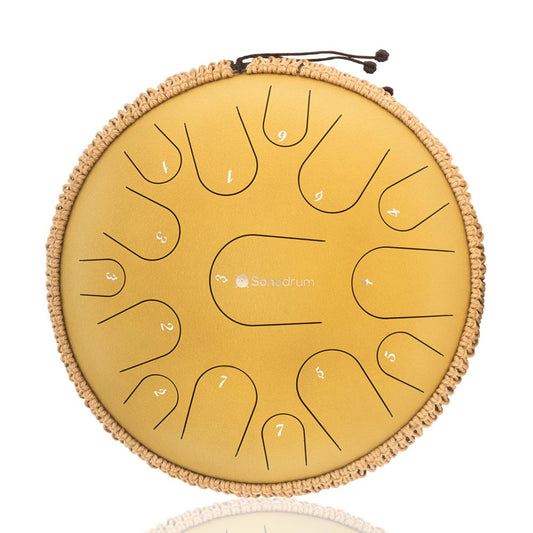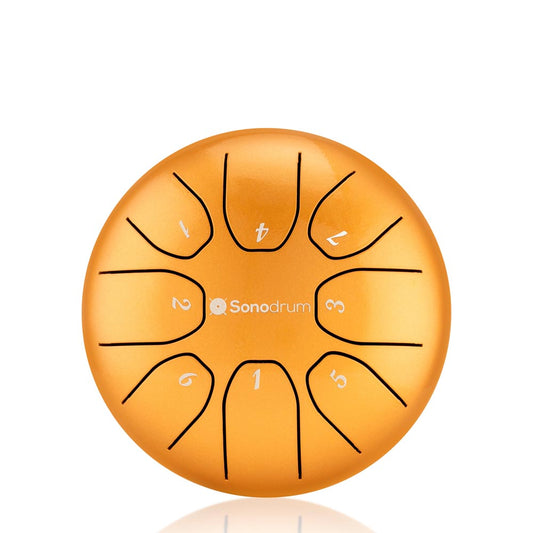What is a tongue drum? Don't worry, they're NOT drums made of tongues! Tongue drums are fortunately mostly made of steel or metal alloys, sometimes also wood. They are perfect for use during tongue drum therapy sessions or simply jamming with friends.
A steel drum is a wonderful object. You don't have to be a musician to play the tongue drum, but it offers more opportunities for creative musical expression and greater versatility than simpler instruments like chimes, bells, and forks.
Have you always wanted to know what steel tongue drums are and how they can be used in tongue drum therapy?
Today, we're discussing this interesting topic because many of our fans have asked us about tongue drum therapy. So, it's time to talk about it and how you too can benefit from the therapeutic advantages of your tongue drums. If after reading the article you're not sure which drum is right for you or a friend/relative, feel free to contact customer service. We're always here for you and can help you with ordering your very own Sonodrum instrument.
The tongue drum as therapy for mind and body of all ages
A tongue drum offers immediate benefits with very little effort or restrictions. Tongue drum therapy is one of these benefits. But first, let's take a look at what a tongue drum actually is.
Tongue drums, also known as hand drums, tank drums, or hank drums, are a type of drum with slits resembling tongues (actually idiophones). They were originally made from repurposed propane tanks. Today, they come in a variety of musical and aesthetic variations - most of them look a bit like flying saucers.
The characteristic u-shaped tongue markings radiate across the surface of the drum, guiding the user to the right places to strike the tones. The drums can be played with bare hands, mallets, or sticks, depending on the type of experience and sound desired.
Reconciling Soul and Body
The gentle, peaceful tones of the tongue drum create soothing melodies that can be enjoyed by all, making them particularly suitable for wellness practices.
Handpan also serves as a therapy for stress.
How do I find the right instrument? Here are a few tips to help you find the right instrument.
Finding the right instrument that suits you is not so simple. Would you prefer to buy a Handpan or a Steel Tongue Drum?
We want to make the tedious process of selecting the right instrument easier for you. In our Sonodrum shop, you'll find a variety of instruments that can create different moods for tongue drum therapy and are made from excellent materials.
Here are some pros and cons of Handpans and Steel Tongue Drums in comparison:
Steel tongue drums
Steel tongue drums are typically smaller but heavier than handpans. They are made of thicker steel and have a much longer sustain than a handpan. They produce a meditative sound but are less suitable for fast, percussive playing.
Advantages
- Very robust, cannot get out of tune
- Not as expensive (purchase price about 1/3 of a handpan)
- Neither sensitive to cold nor heat (-10 to +45 degrees Celsius)
- Can also be played with mallets
- Smaller than handpans
Disadvantages
- Heavier than a handpan
- Not as loud as a handpan
- Less variety in tones
Handpans
Handpans can be played much louder than steel tongue drums and have a magical sound that captivates many. They are therefore particularly popular for combating stress. You forget the world around you and your worries when you follow the sound of the handpan.
Advantages
- Larger note fields, easier to hit
- The sound is "magical"
- Suitable for faster playing
- Larger selection of manufacturers, materials, scales, and more variety
- Is much louder than a steel tongue drum and can still be heard well even in louder background noise
Disadvantages
- More sensitive, can get out of tune faster
- More expensive than a steel tongue drum
- Sensitive to heat (sun!)
- Needs to be retuned approximately every 1-6 years (depending on playing style / handling and manufacturer / material)
- Handpans not made of stainless steel can rust.
Helping the Soul with the Lotus Drum
Steel tongue drums are known by different names, with the Lotus Drum being one of them, especially when the tongues feature floral designs. However, the principle remains the same. The Lotus Drum assists us in combating stress, turning inward, attaining a meditative state, and thereby aiding our soul.
Lotus Drum: Listen, Play, Relax
Everything in this universe is in constant motion (known in science as entropy, i.e., molecular vibrations of the system), including our bodies, most definitely. This means that every organ, tissue, or cell has a "healthy" resonant frequency.
When this frequency changes, the organ begins to deviate from the general harmonious chord, which can signal the presence of illness. However, the illness can also be healed by sending a healthy impulse with that frequency. In other words, restoring the natural frequency will prompt the body to begin healing itself.
Music, where sounds and rhythms adhere to the laws of harmony (consonance), positively affects the health and development of humans and all living beings. This is scientifically proven. In fact, the principle of resonance underlies all known forms of sound therapy, including tongue drum therapy.
This, in turn, profoundly influences human mental development, feelings, emotions, and aspirations.
Stimulate the Brain with Gentle Handpan Music
Sound healing has been utilized by diverse cultures such as the Chinese, ancient Egyptians, Native Americans, and even the US military to restore balance and happiness, treat mental illnesses, and achieve peak performance. It is claimed that sound healing can alleviate developmental disorders, depression, and anxiety, as well as assist in coping with physical and mental pain. For healthy individuals, engaging in their own tongue drum therapy can be a way to recover from daily stress and enhance communication, productivity, and well-being.
Our physical and emotional - perhaps even spiritual - state can be perceived as a specific blend of frequencies, from our heartbeat and blood pressure to the pace of our thoughts and movements. Due to a negative feedback loop, the human body and mind can sometimes remain in a self-reinforcing state of stress or imbalance. And that's not good. Many individuals may not even realize the extent to which they are subject to constant stress.




